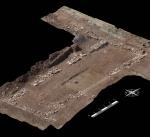Summary (English)
House alpha at Serra del Cedro, discovered in 2016, is a typical basic pastas house. The original layout was very simple: a rectangle 11.27 × 19.50m. The house was divided lengthwise in two parts of the same width by a substantial partition wall. The eastern half of the house was not divided further. It was one long room, the pastas, with a wide opening to the exterior formed by a threshold of small sandstone blocks, placed almost at the centre of the facade. The impression of a column was visible on the central slab. The column’s Doric capital was found two metres away from the centre of the stylobate. Three rooms opened onto the pastas. The central and south rooms were more or less the same size, with wide entrances that were slightly off-centre. The north-west room was almost square, and its doorway was completely off-centre. The great simplicity of the original plan was perfectly legible despite the additions in front of the east facade. The construction of the house can be dated to within the second half of the 4th century B.C. For the moment, a single fragment of a black glaze cup with an overhanging rim, found above the house, could take the date for the destruction of the house back to the second half, or even the last quarter of the 3rd century B.C.
Surface survey continued on the eastern hill of Serra del Cedro, and traces of the site’s fortifications were looked for. The investigations made use of an analysis of the Lidar data that revealed strong linear anomalies around the site. The most useful results relate to the southern hillside: four parallelepiped blocks in a fallen position, two of which bearing quarry marks, and above all a section of wall still in situ. A trench was opened here that revealed the external facing and part of the emplekton.
- Olivier de Cazanove (Université de Paris-I-Panthéon-Sorbonne)
Director
Team
Research Body
- Ecole française de Rome
Funding Body
- UMR ARSCAN
- Université de Paris-I-Panthéon-Sorbonne






![Download [PDF]](/excavation/skins/fasti/images/results/download_sml.png)